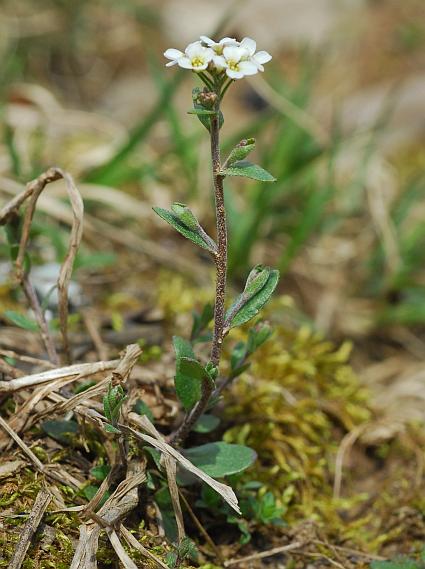Draba brachycarpa Nutt. ex Torr. & A. Gray
Whitlow Grass

Native
CC = 0
CW = 5
MOC = 72
© SRTurner
Draba brachycarpa Nutt. ex Torr. & A. GrayWhitlow Grass | |
 |
Native CC = 0 CW = 5 MOC = 72 |
© SRTurner |
|
Family - Brassicaceae Habit - Annual taprooted forb.
Stems - Erect, to 20 cm, single or multiple from the base, unbranched below the inflorescence, purplish in strong sun, hairy.
Leaves - Basal and alternate, simple, entire, 0.3-2.0 cm long, sessile or the basal leaves sometimes short-petiolate, linear to obovate, often with 2 small teeth, densely pubescent with forked hairs on both surfaces. Stem leaves relatively evenly distributed along stem.
Inflorescences - Few-branched panicles or less commonly racemes, elongating in fruit. Pedicels to 5 mm long in flower. Pedicels and axis densely pubescent.
Flowers - Sepals 4, 0.5-2.0 mm long, oblong-ovate, round at the apex. Petals 4, 2-3 mm long (sometimes absent), erect to spreading, distinct, white, short-clawed, glabrous. Limb obovate, entire, rounded at apex. Stamens 6, erect. Ovary glabrous, 1 mm long, slightly compressed, ovoid. Styles absent or to 0.1 mm long.
Fruits - Silicles 2.5-4.5 mm long, narrowly elliptic to lanceolate or narrowly oblong in outline, glabrous. Seeds 8-15 per fruit.
Flowering - February - April. Habitat - Forests, glades, prairies, streambanks, fields, pastures, railroads, roadsides, frequently on acidic substrates. Origin - Native to the U.S. Lookalikes - Other species of Draba, especially D. verna, D. reptans, D. aprica; also Holosteum umbellatum. Other info. - This tiny native species is one of the first plants to bloom in the spring but is often overlooked because of its small size. The plant has a short flowering period and is most commonly encountered in fruit. It is found throughout Missouri, less commonly in the northern and northwestern regions of the state, and across the southeastern quadrant of the continental U.S. It is relatively easy to identify with some attention to detail. The four white petals are not cleft; the leaves bear forked hairs and are evenly distributed along the stems, and the fruits are glabrous. Photographs taken at Eagle Bluffs Conservation Area, Boone County, MO., 3-14-03, and off Lee Rd 10, Lee County, AL., 2-16-06 (DETenaglia); also at Little Lost Creek Conservation Area, Warren County, MO, 4-25-2014 and 3-18-2017, Kirkwood Park, St. Louis County, MO, 4-2-2019, Shaw Nature Reserve, Franklin County, MO, 4-3-2019, and Amidon Conservation Area, Madison County, MO, 3-26-2020 (SRTurner). |